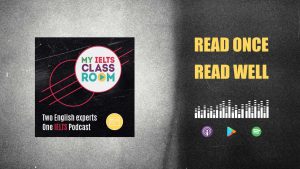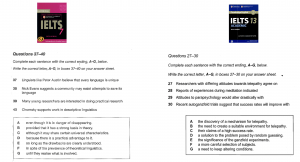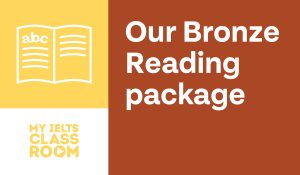
IELTS Reading Matching Sentence Endings
Hey! In IELTS reading matching sentence endings is a strange question type. At first glance, they can seem simple. After all, your only task is to match the start of a sentence with its correct end. And, as all of the possible endings are given to you, the challenge seems minimal.
However, as we will see today, matching sentence endings questions are unique as they rarely contain clear scanning words. This makes them unique as they are both “slow” (because identifying the sentence that contains the answer can be difficult) and “quick” (because once you find the sentence, locating the answer should be easy).
Therefore, the key to finding the sentences is reading for meaning, which is what we will teach you in today’s episode!
If you have no idea what I am talking about when I say “quick” and “slow” questions, then I recommend you check out our most popular reading lesson: Read Once, Read Well.

Below, you can find a summary of the episode, which includes all of the links to useful materials and the times of each part of the discussion (so you can go directly to the part you want to listen to) 🚀
- Subscribe to My IELTS Classroom podcast on Apple podcasts here
- Subscribe to My IELTS Classroom on Google podcasts here
- Become a Patreon to gain access to extra BONUS episodes here

IELTS Reading Matching Sentence Endings Basics
The concept of matching sentences is pretty basic. You will be given the first half of a number of sentences (usually 4 – 6) and a box that contains the correct endings to each of the sentence. Your job will be to match the correct start of each sentence to the correct end. However, there are 2 or 3 extra fake sentence endings in the box that are there to distract you from the right answer.
The two key things to remember when matching ending questions is:
- the questions always follow the order of the passage – this is important as it means you only need to focus on the first question at the start of the text.
- the question stems rarely include a scanning word – this is important because it means that you will need to read for meaning to tackle these questions well.
What skill do IELTS Reading Matching Sentence Endings test?
Great question! That shows me that you are progressing as a student! As you know, each of the IELTS question types is devised to test a different aspect of reading. Headings Match, for example, test your ability to summarise information, whereas T/F/NG are testing your detailed understanding of a short part of a passage (usually a single sentence)
What makes Matching Sentence Endings questions so interesting is the skills they test has changed over time. Look at the following examples of the question. The one on the left is taken from Cambridge IELTS 7 and the one on the right is taken from Cambridge IELTS 13.
Look at the potential sentence endings in the boxes. Can you spot anything different about them?

Well done! You spotted it! All of the potential endings in Cambridge 7 start with a subordinator. More importantly, they start with subordinators that have four different distinct meanings:
- Concession: even though / although / in spite of
- Condition: provided that / so long as
- Reason: because
- Time: Until
Therefore, until roughly Cambridge 8, IELTS reading matching sentence endings questions tested two facets of your English – your understanding of a particular sentence and your grammatical understanding of how to recreate that sentence using the correct subordinator.
Today though, the questions are different. All of the potential answers in Cambridge 13 are simply noun phrases. That means you will no longer need to understand the function of different subordinators to answer the questions. All you will need is to understand the MEANING of the sentence and find the correct paraphrase from the box.
The best approach to IELTS Reading Matching Sentence Endings questions
1. Find the sentence in the passage that the start of the sentence refers to
When I was still teaching in classrooms, I observed that a strange phenomenon occurred when students tried to answer these questions. I noticed that unlike any other question, students would attempt to answer these questions WITHOUT reading the text!
I mean, the endings to the sentence were right there in the box, so why waste time reading and trying to find the sentence in the text, right? Wrong!
Now that there are no subordinators, every ending in the box can grammatical connect to the start of every sentence.
Or, in other words, the only way that you can find the answer is to locate the corresponding sentence in the passage. However, as we will see in the lesson, finding the sentence that contains the answer is not easy. Why?
Because there are rarely good scanning words in IELTS reading matching sentence endings questions.
Look at the four question stems here. What words do you think would make good scan words?

Having not read the text, you may have answered “telepathy” (27) or “parapsychology” (29) as these are unusual words that you would rightly think are unique in the text. However, I hate to say it, but the whole text is about telepathy and parapsychology, so you will find those words in every paragraph.
“Autoganzfeld” (30) would also seem to be a good scanning option, but again, these tests are mentioned in 4 of the paragraphs in the passage, so it is again unhelpful as a scanning word. That means that in all four questions, there is just one good scanning word – “meditation”.
What does that mean? Well, it means that you are going to have to read the whole passage to locate the answers as scanning and skimming will not help you. More importantly, you will need to read for MEANING as the sentence that you are looking for will include a lot of paraphrasing and synonyms. However, if you are using our Read Once, Read Well method, this should not be a problem.
2. Read and understand the sentence. Do NOT look at the options in the box yet.
This is key. Too many students jump straight from finding the sentence to looking at the potential answers in the box. However, doing this is likely to lead to confusion. The way to avoid being caught by the extra distractors in the box is to read and understand the sentence first BEFORE you look at them.
3. Try to complete the sentence in your own words
Undoubtedly, this is the most important step. If you are able to complete the sentence with your own ideas, you have a very high chance of being able to locate the correct sentence ending in the box.
As we will see in the lesson, you may be able to formulate more than one possible ending for each question stem. That is great! Recognising that the question could be completed logically in more than one way shows that you are interacting with the text and have understood it well.
4. Find the sentence ending in the box that matches your own ending
Once you have understood the sentence and predicted how it could end, then, and only then, you should look in the box to select your answer.
Trust me, if you have read and understood the sentence, you should be able to identity the correct answer in seconds.
After all, if you know how the sentence ends, all you are really doing is “matching” your own paraphrase with one from the box, and this is a relatively simple process. In fact, you may find that the answer is not really a “paraphrase” at all as many IELTS reading matching sentence endings answers use words that are directly taken from the text.
Why? Because this question is not really testing your ability to paraphrase (those are the usual box matching questions) but that you can predict and identify the end of a sentence based on its function.
Will I find the answers to IELTS Reading Matching Sentence Endings questions in one paragraph?
The answer to that is simply “I do not know”. There are no rules for where the answers will be other than the fact they follow the order of the text. In the example we cover in the episode, two answers are found in the first 3 paragraphs, then there is nothing for the next 4 paragraphs, and then the final two answers are found in the final 2 paragraphs.
For a student who is trying to scan, this would make finding the answers very time consuming. My advice, therefore, would be to answer these questions using the Read Once, Read Well method so that you can pick up the points from the other questions as you read.
Would you like expert help to improve your IELTS reading score?
We offer a 5-day intensive course for IELTS test-takers every month that covers all aspects of reading from how to approach every type of question to how to “read one, read well” to manage your time more effectively. Even better, with every course having no more than 8 students and being run by an ex-examiner, you will be getting personalised advice that is guaranteed to help you to improve your score.
Find out more about the course and how it can help you hit your target score here.

